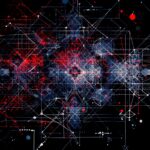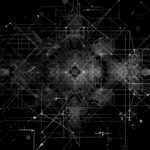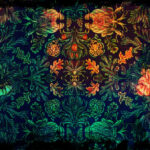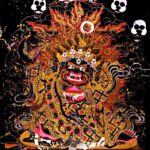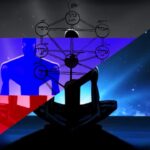This article is a transcript of the presentation for the November 11th, 2022 exhibition, Tecnomemories: fossils of the present, held in Milan at Frigoriferi Milanesi and organized by Chaosmotics and the Uno+Uno+Uno association.
We are walking among the ruins of the Etruscan city of Veii.
It existed as early as three centuries before the founding of the Urbe, at a distance of about fifteen kilometers from the area where Romulus drew the primeval furrow, the pulcherrima1. To Rome, the Etruscan city would be an irreducible fragment of its millennial history. After ten years of siege, and three and a half centuries of struggle, Veii would fall in 396 BC. It will be Marcus Furius Camillus – acclaimed by all as “the second Romulus,” says Eutropius2 – who will sanction its end by means of acumen, digging a tunnel under the walls. One hundred years after the birth of the Republic, and by now three hundred and fifty years after its founding, for the Roman people the victor of the veientes will merit the title of second founder. Camillus assumed the name of the pater patriae par excellence. For the ancients, names were a serious matter.
We walk among the ruins. We observe what remains of the foundations, what remains of the surrounding walls. There are few objects around, perhaps a few shards from some recent excavation. The ground is lush with green grass. The landscape is not unlike what we would observe in a paleontological excavation. Bricks take the place of bones; the silence is the same. We walk, and we wonder: where are these Etruscans? Like Hofmannsthal on the Acropolis in Athens, lost in apathy to the silent ruins – “A feeling of disappointment assailed me […]. These Greeks, I asked inwardly, where are they? I tried to remember, but I remembered only memories.”3. Those traces of passage, fossils of a very distant yet priceless history, cannot tell us much about who the veientes were, and the people to whom they belonged. “Where are these Etruscans?” we ask the good archaeologist who accompanies us, acting as our guide.His gaze leaves the ground on which our feet rest, and runs to the surrounding hills. “Not here, but all around” – he replies.
Veii is surrounded by fifteen necropolises, as well as various mounds scattered around the area. Fifteen cities of the dead around the city of the living. “Anyone who wants to know about a civilization must observe how it buries its dead” – our guide is keen to instruct us. Somewhere we remember, in fact, reading that to know what level of social, cognitive, and symbolic development our ancestors stood at – even from the history before history – we should have asked, “Did they bury their dead?”. The how and why would not, indeed, have been of immediate importance; if the answer had been positive, we would have known enough already. We would have known that these men lived in a world they had begun to create themselves.
***
Burial is one of the very few practices that unite social agglomerations in space as much as in time. Archaeological evidence tells us of Neanderthals, already digging graves in the ground – stone structures that covered the body of the deceased, placed alongside their tools and animal bones. But burial is not simply an “act of care,” or some form of sanitary attention. One may happen to think of civilizations such as the Egyptians, or the Etruscans, and recognize that the obsessive attention placed on caring for the deceased was primarily religious in nature – linked to their specific cosmologies and their considerations of the soul, of life, and its transcendence. The fact that burial is seen – that the mound, the tomb, the necropolis are complex artifacts designed to last a long time and remain present in the eyes of the living – perhaps indicates that the issue does not stop only at the threshold of individual life. The tomb is part of the city, the landscape, the territory.
An artifact of this nature expresses a social function. Within the territory of an urban agglomeration, the existence of cities of the dead is a fact that explains to us how for those men – who are also us – biological death is not equivalent to social death. The necropolises of Veii are signs, and as signs they are integrated within a discourse – the logos of a people, its entire world. With death one becomes something else, for society, but one does not become nothing – if the social body decides and accepts it.
Let us try to look at this object, the grave, in relation to what it springs from – the need we assume it goes to satisfy. It would be easy for us to think of the relationship between the grave and death – the grave saves the deceased from disappearance. But the deceased is, in fact, at some level, missing.
What is it that the grave contains, if it appears as an integration of death into the social order? It can be said: an immense descriptive and narrative effort that the social body enacts. The grave is the casket that contains the representation of the deceased. The buried is a patchwork of denotations: his tools in life, the decorations that tell his story, his possessions, his body, a photo of her. A room full of mirrors; all the things that make up the picture of this “individuality”, which seems quite divisible indeed. But for whom? Let us try to speculate: for society itself, its “world,” for which burial is an absolutely vital act – an act through which it shows itself alive and through which it survives. In the web of representations that constitute the social world, the living and the dead are never really different. At the bottom of this, that which is lost is the single living, the concrete presence of (a) consciousness.
In this sense, by looking at a tomb we can intuit the life form of a social body, the way this animal breathes and moves. It is no accident that at the high points of a civilization, the construction of monuments proliferates – which, as Nietzsche teaches us, are but epitaphs to a history4. A living society is a machine that mirrors itself, producing representations that define its identity through the materialization of what is externalized in memory. Society itself is a patchwork of denotations, a body that observes itself reflected in the mirrors it has produced. Graves are therefore systems of self-remembrance, mirrors in which to reflect and contemplate one’s own image.
The object we see in the work Not even a God can Understand a Girl with a Smartphone has characteristics, at first glance, different from the objects and decorations chosen by those who perform the funeral rite for the deceased. First of all, because it is the object that is “the deceased.”
The idea of burying a smartphone, however, does not seem so alien to us. On the contrary, it seems to effectively describe something of the relationship with our world. The burial of the deceased is an act that sets in motion a collectivity of subjects who welcome the death of an individual through a representational mnemonic effort. The deceased is buried with what represents him – at one time it was the trousseau of objects he used, the jewelry that declared his rank; today, it is the picture of his face at a given time, an impression, the period in which he lived, perhaps a phrase that identifies him. Burial seems to make up for the disappearance of the present consciousness, as a lived and living life, thus affirming, in contrast, the vitality of a social body that denotes him, connotes him, recognizes him. The dead person continues to live as representation, according to the set of references that the social body decides to use.
The smartphone, or the computer, which are objects with which we have an extremely intimate relationship, share with the functional structure of the grave the fact that they are reserves of descriptions. In them, in the digital space to which they are connected and which they constitute, is crammed a very extensive system of descriptions of ourselves, and these act as mirrors: they return fragmented reflections to us among documents, photos, messages, videos, programs and applications, system preferences, and desktop icon sorting. And these same images are in turn returned to the social body, which makes use of them as it wishes. My smartphone is me as an inscription system. We can better understand, then, the affectivity that binds us to these objects, and which is represented in the work Not even a God. An object like a smartphone that stops working, as a storehouse of individual fragments of ourselves in which we recognize ourselves, is an absolutely abysmal event for our lived experience. What it contains is often not materially quantifiable – the pc can be perceived as the container of “my whole life.” Instead, the promise of an ethereal non-place, the cloud, to save that life from dependence on material media, tells us of an extreme alliance between objects instead. As expressed in a passage in The Land after Time, the cloud decentralizes this dependence, but is far from erasing it; it reorganizes the relationship between the one and the many – the bit is not bound to a single unit of memory, a pc, but survives through the interconnectedness of a system of material media. The Platonic Idea cannot extricate itself from the statuettes – or even from their shadows.
The question, at this point, must necessarily take memory into account. If we said that the technical object that connects us to the cloud and the tomb share a same functional structure, it is because both result as containers of a certain kind of remembrance: re-presentation (bringing back to presence), or re-membrance (bringing back into the limbs, re-embodying). For whom is this re-presentation? And does it make sense to ask? It has been said: on the one hand, the social body produces itself through the grave and through digital information, through numerous mirrors in which (it) reflects itself. On the other, there is the disappearing residue, that for which the juxtaposition of objects – even the body – in order to return an image takes on meaning. But image of what? Therein lies the mystery, the blind spot. Not because we do not intuit what is what whose image is to be returned, but because we cannot tell: it is constitutively a mystery. It is something we hypothesize similar to “our” firsthand experience, but such knowledge is always forclosed. Beyond the limit of description, no light can help us. Even empathy, however celebrated, is not the key to crossing any threshold: it declines, translates, welcomes the intuited content of another subjectivity into our own. A good actor will always know how to make us feel things that he himself does not feel.
The unpresentable residue of personal experience is non-relational; it escapes the network of representations that encodes and constitutes the social body. But the latter is not a who, it is not sentient – except through that very residue that it cannot recognize as its own. In The Land after Time, the voice of the artist states at one point that “without memory, traces have no meaning – they are shells without their ghosts.” Following what we have said, if by traces we mean objects, as something like a shell, the juxtaposition of memory and ghost might lead us to think that behind traces, objects, behind tombs, monuments, decorations, tools, machines, there is something else from which everything else springs. A dangerous ontological hierarchy – the ghost, the residue, full of value and truth, and the shell, empty trace. Put in this way, the trace – the concrete materiality – would contain a memory, its “ghost,” or its spirit, its breath. The trace is, in fact, a trace of: something operates in the world in such a way as to manifest in the landscape the clue to the presence of an immediately recognizable agentivity – a sign, a signifier. Each shell is a part, a fragment, or a system of fragments of the ghost; it is the ghost in its own absence from the regime of language – this mystery of firsthand living experience – as a self-sufficient principle. And so any attempt to rescue the ghost – Everything not saved will be lost, as it is said in the piece – is a demonstration of the interpenetration between the shell and the ghost and, if you will, between the “artificial” and the “natural” on the same plane of immanence, in this mystery of that which, ultimately, cannot be reflected in any mirror. Are there reasons to think that this agentivity is a separate object from the shell through which it operates? Is there a difference between shell and ghost?
Let us say that by shell we mean the potentially endless set of individual representations that make up the image of an individual, as in the grave. And by ghost we mean the first-person, singular, irreducible, and immeasurable lived experience that these representations attempt to reconstruct. An individual consciousness, from the perspective of the Other, is composed of traces that represent its presence, but not its sense of “interiority” – being that consciousness. It is, moreover, immersed in a world of further traces afferent to society and culture, thus inherited, received, assumed into itself.
First-person experience is not merely one object among others, but rather what the system of objects, of traces, of memories, attempts to reconstitute and reintegrate within a given system of references – within a given world, a framework. The identity politics that are prominent in contemporary debate today manifest this unreflective presence that attempts to assert itself by disrupting the system of references in which it is immersed precisely because it is a system of images incapable of exhausting, through representation, individual experience. Such lived experience, the moment it does not find identity between its own feeling and the system of references in which it is immersed, produces a tear, rejects the forms of identification by which the social body attempts to integrate it. In appearing exactly as an elusive experience, it manifests at the same time the form of life of a world as a mere system of images – the rigor of its own structures is revealed as rigor mortis. As in a house of mirrors, where the only way out is to rely more on touch than sight, the residue emerges when it stops mirroring itself and returning a reflection. When, therefore, it discovers itself shattered.
***
“If one comes from Shiragi, he reflects Shiragi, while Japanese people reflect Japan. The sky reflects the sky and the people reflect the people. We have thus studied coming and reflecting, but we do not know the true meaning of reflecting in relation to the mirror; we simply experience it. “What happens if suddenly a clear mirror appears?” The answer, “It will shatter into a thousand parts.” In other words, the clear mirror, the moment it suddenly appears, shatters. Investigating these parts is, itself, the clear mirror. If we try to grasp the clear mirror, it will certainly shatter into many pieces. Shattering into pieces is, that same, the clear mirror. We should not speculate that there is a time, in the past or future, when it does not shatter: it simply shatters.”
This enigmatic passage from the treatise Kokyō, in the Shobōgenzō (Eihei Dōgen, 13th cent.), may be helpful in understanding what has been said. In an important text in which he reflects on the question of material support, Lyotard comments on this passage saying, “So there is a breaking presence which is never inscribed nor memorable. It does not appear. It is not a forgotten inscription, it does not have its place and time on the support of inscriptions, in the reflecting mirror. It remains unknown to breachings and scannings”5. In other words, the set of objects that make up “the shell”, as a system of representations directed for the purpose of reconstructing an unpresentable presence, would seem to refer to the latter as a foundational a priori. But the “shattering into pieces is, that same, the clear mirror”, this presence, its constitutive operation.
Let us then review what we extracted from The Land after Time – “without memory, traces have no meaning – they are shells without their ghosts” – in a different key. Let us start again from Veii. Leaving the ruins of the city and following what remains of the roads, we head for the necropolis. Our good guide shows us the grave goods, and the shape of the burial chambers and mounds.
“From this we understand what people they were, what objects they used, what they considered valuable, and how society was divided,” he instructs us. We have no memory of any of this – it is part of another world – and it means something to us only in a way that is inherent to our own world.
“But what did it mean to be an Etruscan person?” – we ask him, genuinely intrigued – “How did an Etruscan suffer? How did he feel fear? How did he experience being a man or a woman?”.
This is what we look for, among ruins and fossils. Spaced out by what seems to him to be a mockery, the good guide will mutter, “What do I know? it’s not like I’m Etruscan!”. Somewhat disconsolate by the rebuke, we wonder among ourselves what we are observing, really, in the tombs. How do we know that those buried there were like us? We observe the objects, the mound, the necropolis, then the ruins of the city. Were there ghosts in these shells? We have nothing but clues. But even if we would know the content of the traces, as signifiers, we would have access only to the ghost of a meaning – not to the potency of a life.
Back home, we remember that the Veientan war is narrated by Titus Livius. We pick up the copy of Ab Urbe Condita that of course we all have on our bedside tables, make to open it and stop: we look at it. What is this object? Is it not memory set aside? The trace of a consciousness that has been alive, present, determined to represent the history of its civilization? Just as fellow citizens construct the patchwork of images to save “the memory” of the deceased, its elusive presence.
Our suggestion then is this: that ghost and shell manifest themselves only reduced to fragments. But also that what the shell attempts to reconstruct, the ghost, is such always and only because of another presence. The ghost is not only outside the shell, but also and always outside itself.
- Titus Livius, Ab Urbe Condita, V, 4, 24
- Breviarium ab Urbe condita, book I, 20
- SW 33, 192
- On the Use and Abuse of History for Life, 7-10
- Lyotard, The Inhuman, Polity Press, Oxford, 1991, 55.



